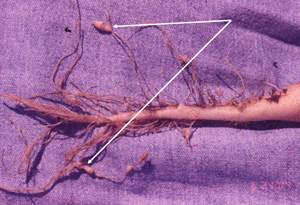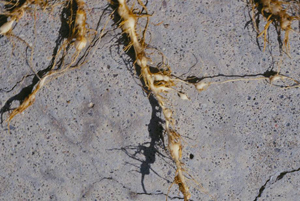G1857
False Root-Knot Nematode
False root-knot nematode is primarily an economic problem of sugar beet, although it can infect other plants. This NebGuide provides more information on this disease, including symptoms and signs, history and management.
Robert M. Harveson, Extension Plant Pathologist
- Introduction and History
- More History
- Distribution
- Symptoms and Signs
- Pathogen Life Cycle
- Host Range
- Management
Introduction and History
The false root-knot nematode [Nacobbus aberrans (Thorne and Allen)] has also been referred to in the literature as the Nebraska root galling nematode and Cobb’s root galling nematode. Nematodes, in the genus Nacobbus, induce galls on roots of hosts, as do species of root-knot nematodes (Meloidogyne), thus they are familiarly known as false root-knot nematodes.
Distribution
In the United States, N. aberrans is primarily an economic problem with sugar beet, although it can infect other plant species, and has been identified in at least nine states. Early surveys (1953-1954) in western Nebraska (Sioux, Scotts Bluff, and Morrill counties) found the nematode infesting 32 percent of 125 sugar beet fields over two years. Geographically, these infested fields were all north of the North Platte River, primarily on coarse-textured soils. None were detected from the primarily silt loam soils south of the river. The nematode is apparently indigenous to this region (also occurring in rangeland areas removed from cultivated fields), but has not spread as readily throughout the sugar beet production areas as the sugar beet cyst nematode. It has been documented to commonly occur in complexes in this region with the sugar beet cyst and Northern root-knot nematodes (Meloidogyne hapla), and was further demonstrated to cause more damage than either of the other two nematode species. Presently Nebraska and Wyoming are the states most affected by this pest, causing 10-20 percent losses in sugar beet crops.
Symptoms and Signs
Fields may be uniformly infested, but severe damage normally occurs only in localized areas or “hot spots.” Infection can occur on young plants (Figure 1), resulting in early season loss of stand. In these situations, foliar and root growth are stunted and severely reduced throughout the season. In mid- to late-season, severely infected plants wilt and exhibit pronounced yellowing during hot periods of the day (Figure 2). The most visible symptom on roots is the presence of galls or swellings with a proliferation of side branches (Figure 3).
Galls induced by the false root-knot nematode are generally irregular or warty in shape as opposed to the smoother, more rounded galls produced by the Northern root-knot nematode. Advanced infections on surviving plants at harvest are characterized by numerous lateral branches formed on mature taproots (Figure 4). These lateral roots may be studded with galls, giving them a beaded appearance, with numerous small rootlets emerging from galls (Figure 5). N. aberrans is unique by being the only known nematode pest that induces the host to produce starch in feeding areas within galls in response to infection. The starch is observed as dark flecks after slicing open galls and applying a potassium iodide solution to cut surfaces, aiding in identification. Under low power microscopes, the female may be teased out of galls, and seen as tapered at both ends, resembling a sweet potato. This contrasts to other gall-producing nematodes that produce a pear-shaped female with a rounded posterior end.
 |
 |
|||
| Figure 1. Early false root-knot infection in young sugar beet exhibiting small discrete galls on feeder roots (arrows). | Figure 2. Wilting and yellowing symptoms from severe false root-knot infection in mid-season. | |||
 |
 |
|||
| Figure 3. Galls and swellings on roots with proliferation of small side branches. (Credit: Erik Kerr) | Figure 4. Mature roots at harvest exhibiting multiple lateral, ropy roots. | |||
|
||||
Pathogen Life Cycle
The life cycle closely resembles that of other root-knot nematodes. Most populations overwinter in soil as eggs. All immature stages of both males and females are migratory endoparasites. The second-stage juveniles hatch and invade roots, where they develop into sack-shaped females and worm-like males. After this, many (but not all) migrate back into the soil. Those migrating females then re-enter other roots (usually larger ones) and force their heads into cortical cells, resulting in increased cell division and true gall formation, before becoming sedentary. Several females may be found in a single gall. The female extrudes eggs in a gelatinous matrix through a small opening formed on the outside of the gall. The life cycle from egg to egg has been shown to take 48 days at 78-80°F.
Host Range
Economic hosts include carrot, pea, lettuce, tomato, and species in the Cruciferae family (broccoli, cabbage, rutabaga, radish, and turnip), and the Cucurbitaceae family (pumpkin, cucumber). Most field crops grown in the central high plains under irrigation other than sugar beet are not susceptible hosts, including potatoes, corn, beans, alfalfa, wheat, barley, and sweet clover.
Common weed hosts include kochia (Figure 6), common lambsquarters (Figure 7), Russian thistle, common purslane, and puncturevine. N. aberrans was also found infecting three species of prickly pear cactus (Opuntia spp.) on uncultivated rangeland in Scotts Bluff and Sioux counties in the Nebraska Panhandle, further suggesting that it is native to this region.
 |
 |
|
| Figure 6. Kochia scoparia (kochia weed, fireweed) infected with false root-knot nematode showing small galls in tap and feeder roots. (Credit: Erik Kerr) | Figure 7. Common lambsquarters (Chenopodium album) root infection with small galls on feeder roots. |
Management
- No tolerant cultivars are available for producers, but planting early will reduce damage from the pathogen when soil temperatures are relatively cool. The longer infection can be delayed, the less potential exists for severe damage to occur.
- Crop rotation with non-hosts will reduce nematode populations.
- Weed control in nonsugar beet crops will additionally help to reduce populations in soils. The nematode can readily reproduce on both kochia and lambsquarters, and failure to manage these weeds may result in ineffective disease control, even when proper rotations are practiced.
- Soil fumigation may not provide satisfactory control if undecomposed, infested, root debris is present in soils after harvest.
- A dependable economic threshold level for false root-knot nematode has not been established, thus the value of soil testing is limited.
- Trap crops used for sugar beet cyst nematode control have shown no effect on false root-knot nematodes.
- Tare soils should not be returned to fields used for sugar beet production.
This publication has been peer reviewed.
Visit the University of Nebraska–Lincoln Extension Publications Web site for more publications.
Index: Plant Diseases
Sugar Beet
Issued May 2008
